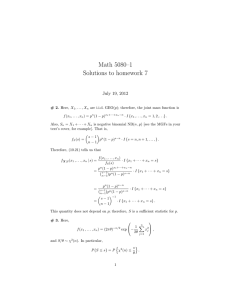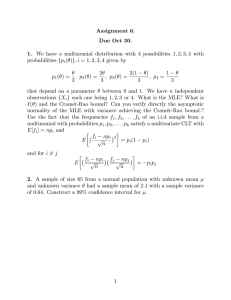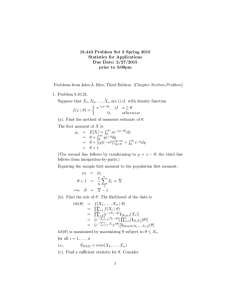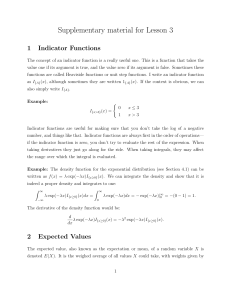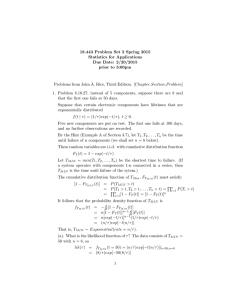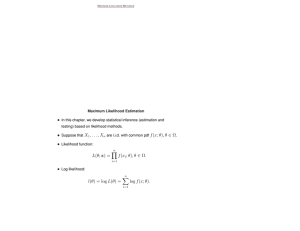Lecture 5. f is a smooth function and t
advertisement
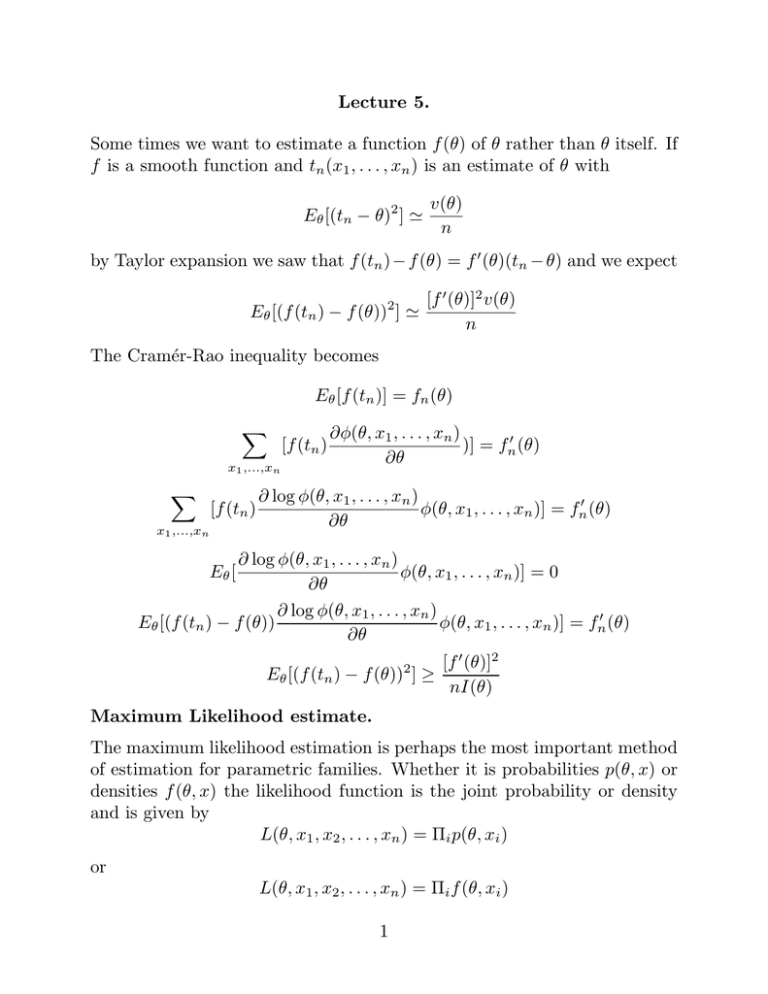
Lecture 5.
Some times we want to estimate a function f (θ) of θ rather than θ itself. If
f is a smooth function and tn (x1 , . . . , xn ) is an estimate of θ with
Eθ [(tn − θ)2 ] '
v(θ)
n
by Taylor expansion we saw that f (tn ) − f (θ) = f 0 (θ)(tn − θ) and we expect
[f 0 (θ)]2 v(θ)
Eθ [(f (tn ) − f (θ)) ] '
n
2
The Cramér-Rao inequality becomes
Eθ [f (tn )] = fn (θ)
X
x1 ,...,xn
X
[f (tn )
x1 ,...,xn
[f (tn )
∂φ(θ, x1 , . . . , xn )
)] = fn0 (θ)
∂θ
∂ log φ(θ, x1 , . . . , xn )
φ(θ, x1 , . . . , xn )] = fn0 (θ)
∂θ
∂ log φ(θ, x1 , . . . , xn )
φ(θ, x1 , . . . , xn )] = 0
∂θ
∂ log φ(θ, x1 , . . . , xn )
Eθ [(f (tn ) − f (θ))
φ(θ, x1 , . . . , xn )] = fn0 (θ)
∂θ
Eθ [
[f 0 (θ)]2
Eθ [(f (tn ) − f (θ)) ] ≥
nI(θ)
2
Maximum Likelihood estimate.
The maximum likelihood estimation is perhaps the most important method
of estimation for parametric families. Whether it is probabilities p(θ, x) or
densities f (θ, x) the likelihood function is the joint probability or density
and is given by
L(θ, x1 , x2 , . . . , xn ) = Πi p(θ, xi )
or
L(θ, x1 , x2 , . . . , xn ) = Πi f (θ, xi )
1
Given the observed values (x1 , x2 , . . . , xn ) this is viewed as a function of θ
and the value θ̂ = t(x1 , . . . , xn ) that maximizes it is taken as the estimate
of θ.
Examples.
1. Binomial. With t =
P
xi the number of heads
L(θ, x) = θt (1 − θ)n−t
d log L
=0
dθ
t
n−t
=
θb 1 − θb
reduces to θb =
t
n
2. Normal family with known variance equal to 1,
1
(x − µ)2
f (µ, x) = √ exp[−
]
2
2π
n
1X
n
log L(µ, x1 , . . . , xn ) = −
(xi − µ)2 − log 2π
2 i=1
2
n
∂ log L X
=
(xi − µ) = 0
∂µ
i=1
n
1X
µ̂ = x̄ =
xi
n i=1
3. Normal family with mean 0 but unknown variance θ.
f (θ, x) = √
1
x2
exp[− ]
2θ
2πθ
n
1 X 2 n
n
log L(θ, x1 , . . . , xn ) = −
xi − log 2π − log θ
2θ i=1
2
2
2
n
1 X 2
n
∂ log L
= 2
xi −
=0
∂θ
2θ i=1
2θ
n
1X 2
x
θ̂ =
n i=1 i
4. Gamma family.
f (p, x) =
1 −x p−1
e x
Γ(p)
L(p, x1 , . . . , xn ) = −n log Γ(p) −
n
X
xi + (p − 1)
i=1
n
X
log xi
i=1
n
Γ0 (p) X
∂ log L
log xi = 0
= −n
+
∂p
Γ(p)
i=1
p̂ is the solution of the equation
n
Γ0 (p)
1X
log xi
=
Γ(p)
n i=1
Properties of a good estimator.
1. Consistency.
Pθ [|tn − θ| ≥ δ] → 0
Enough if Eθ [|tn − θ|2 ] → 0.
2. Efficiency
The variance Eθ [|tn − θ|2 ] must be as small as possible. If the Cramér-Rao
bound is approached it is good. Asymptotically efficient.
nEθ [(tn − θ)2 ] →
1
I(θ)
3. It is good to know the asymptotic distribution of tn . A central limit
theorem of the form
Z x
p
√
1
y2
√
P [ n(tn − θ) I(θ) ≤ x] → Φ(x) =
exp[− ]dy
2
2π −∞
3
will be useful.
4. If there is a sufficient statistic MLE is a function of it.
Theorem. If f (θ, x) is nice then the MLE satisfies 1,2 and 3.
Explanation. Why does it work? Consider the function log p(θ, x) as a
function of θ and compute its expectation under a particular value θ0 of θ.
p(θ, x)
Eθ0 [log p(θ, x)] − Eθ0 [log p(θ0 , x)] = Eθ0 log
p(θ0 , x)
p(θ, x)
≤ log Eθ0
p(θ0 , x)
X
= log
p(θ, x)
x
=0
If the sample is from the poulation with θ = θ0 by the law of large numbers
the function
1
log L(θ, x1 , x2 , . . . , xn ) ' Eθ0 [log p(θ, x)]
n
has its maximum at θ0 . Therefore L(θ, x1 , x2 , . . . , xn ) is likely to have its
maximum close to θ0 .
More Examples.
f (θ, x) =
1
;
θ
0≤x≤θ
1
θn
θ wants to be as small as possible. But θ ≥ xi for every i.
f (θ, x1 , . . . , xn ) =
tn (x1 , . . . , xn ) = max{x1 , . . . , xn }
Multiparameter families
1.
1
(x − µ)2
f (µ, θ, x) = √
exp[−
]
2θ
2πθ
4
n
n
n
1 X
log L(θ, x1 , . . . , xn ) = − log 2π − log θ −
(xi − µ)2 ]
2
2
2θ i=1
∂ log L
= 0,
∂θ
∂ log L
=0
∂µ
n
1X
(xi − µ)2 ;
θ=
n i=1
n
X
(xi − µ) = 0
i=1
n
1X
µ̂ = x̄ =
xi
n i=1
n
n
1X 2
1X
2
(xi − x̄) =
xi − x̄2
θ̂ = s =
n i=1
n i=1
2
2. Multivariate Normal families. x = {x1 , . . . , xd }, µ = µ1 , . . . , µd ∈ Rd .
A = {ar,s )} is a symmetric positive definite d × d matrix.
f (µ, A, x) = ( p
1
2π|A|
)d exp[−
< x, A−1 x >
]
2
Z
xr f (µ, A, x)dx = µr
Rd
Z
(xr − µr )(xs − µs )f (µ, A, x)dx = ar,s
Rd
n
1X
µ̂r = x̄r =
xi,r
n i=1
n
âr,s
n
1X
1X
=
(xi,r − µr )(xi,s − µs ) =
xi,r xi,s − x̄r x̄s
n i=1
n i=1
5

